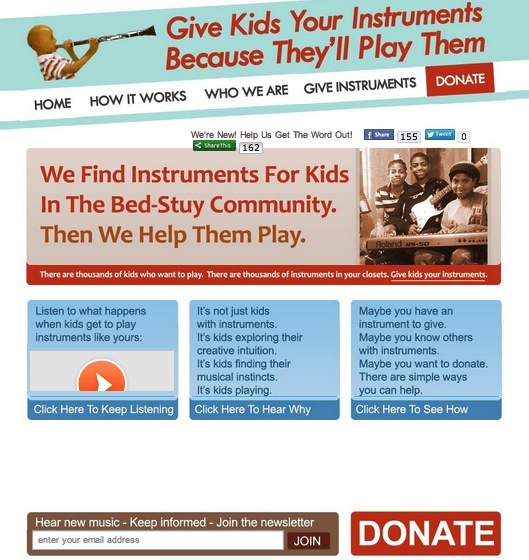In summer 2011, Mitch Van Dusen and Lech Szporer happened upon an impromptu jam session in their Bed-Stuy, Brooklyn, NY neighborhood.
Van Dusen and Szporer — musicians and creative collaborators with a studio space nearby — dug what they heard, so they brought down some instruments and joined in.
“We ended up playing over an hour,” Van Dusen recalls, “just banging on stuff with kids.”
The two packed up and turned to go, but the kids weren’t having it.
“They ran upstairs past us, and started playing instruments.” Out of the six or seven children who stormed the studio that day, only one had any musical training. What happened next was really something: In less than an hour, “Kickstand and the Butterflies” had written their first song.
“Watching these kids with no training just so effortlessly start creating sound … it was frankly brilliant.”
Over the next several months, the same group of children, ages 5-14, came by every day to hang out and play instruments. Van Dusen and Szporer recorded several tracks with them — never intervening much, just letting the youngsters do their thing and watching what happened.
“We just grew this amazing bond with them,” Van Dusen continues. “I learned more from them about music than in many other formal lessons.”
“That Christmas, Lech and I were sitting in a coffee shop and saying, ‘wouldn’t it be nice if we could get these kids some instruments for Christmas?’ A woman sitting nearby overheard their conversation, and offered a guitar and amplifier she had sitting around. That moment was their epiphany: Give kids your instruments, because they will play them.
The organization’s primary focus at the beginning was an instrument drive — getting folks to send in their unused instruments, that were just sitting around in closets collecting dust.

They soon realized it’s not enough to hand a kid a trumpet and tell ‘em to have at it. Just as important, they saw, was ensuring children had a creative environment to explore and have fun. “More than just teaching the kids music, we’re giving them and environment where they can explore,” he says. “We’re not teaching formal music at all.”
Give Kids Your Instruments is in talks with a small private school, where there’s a decent chance they’ll be able to open a community music and creative arts room. Another project in the works is the construction of large-scale “sound playgrounds” — essentially, Van Dusen describes, “sound sculptures, a big living instrument these kids can play with the abandon they would on the playground.”
“With the kids, it’s such an organic process. ... One of the things that has become so clear is that kids have a certain reckless abandon that they have easier access to than us adults. As kids grow older, they lose that — it’s not accepted. But when kids are kids, whatever they have inside them is so much more likely to just pour out.
“When people listen to the record on the website, and they keep in mind that this was done with very little practice, that this was natural, kids being kids creating songs on the fly — as adults, this is such a profound lesson … all those things we enjoyed as kids without thinking about them. If more of us were taking a peek to peer into the minds and the souls of these kids, we have so much to learn from them. All it takes is a little consideration. You see it real quick if you look.”
Visit Give Kids Your Instruments.

Michael
on 08 Aug 13This is an inspiring local organization and because of this article I’ve taken first steps to seeing something similar exist in our area. I consider music to be tied with literacy in importance and ability to bring joy to many people. Thanks for sharing.
I’m commenting only just now because for some reason I had a little difficulty getting my eyes involved in this story, and I passed it over the first time. I’m not sure why that is—but hopefully it’s helpful feedback.
Carl
on 12 Aug 13Inspiring
This discussion is closed.